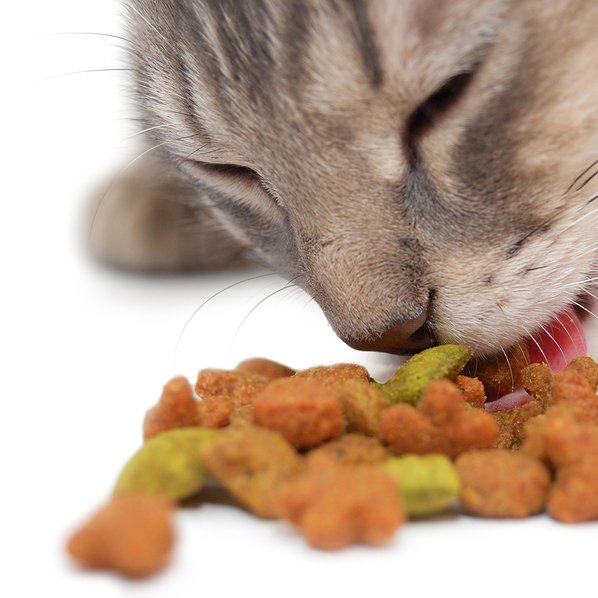Unlike dogs — who will do just fine on a mix of meat, grains, vegetables, and even fruits — cats are obligate carnivores. That means they must eat primarily meat. Research suggests that foods packed with carbohydrate fillers aren’t good for cat health.
With that in mind, there are lots of right ways to feed your cat. Store-bought food, home-cooked food, and raw food can all be healthy. You just need to arm yourself with a little information, so you can tell the good from the bad.
Shopping for good cat food
The main advantage of commercial food is convenience. All you have to do is open and serve, and if it comes from a major manufacturer, you know it’s been formulated to meet all your cat’s nutritional needs. Still, quality varies.
Reading labels
A few guidelines can help you decode all that fine print on the cat food label:
- Ingredients must be listed by amount in descending order. So if chicken is the first ingredient, technically the food contains more chicken than any other ingredient. If the four ingredients following it are all grain, however, if you were to put them on the scale with the chicken, the flour would probably outweigh the fowl.
- If meat is the first ingredient but it’s followed by several grain ingredients, the food is grain-based, not meat-based. Look for a better food.
- The first ingredients should be animal protein sources you recognize, such as chicken, lamb, or turkey. Avoid foods that list by-products, animal digest, or the generic term “meat” among the top ingredients.
- Avoid foods that contain corn, corn gluten, corn gluten meal, rice, wheat gluten, and soybean products. These starchy grain products contribute to obesity in cats, and corn and soy in particular are common allergens in pets.
- Words like “natural,” “premium,” and “human grade” have no official legal definition. Manufacturers know these terms make consumers feel good about what they’re buying, but they don’t guarantee anything about the actual product. The words “complete and balanced,” however, mean the food has been tested in cats or formulated to meet all their nutritional needs.
Dry food versus canned
Many people like the convenience and long shelf life of dry cat food, but some research shows that canned food is better for your cat’s health. Here’s what you should know when you decide on canned food versus dry:
- Cats who eat canned food tend to be less prone to obesity, diabetes, and other health problems, perhaps because dry foods contain more carbohydrate (which cats don’t metabolize as well as protein) and less water.
- Dry food doesn’t really clean your cat’s teeth. It has that reputation, but it’s not really borne out by research. Don’t think you can skip brushing Binky’s teeth if you feed a dry diet.
If you still want to go with dry food, try to limit it to half your cat’s food intake, with the remainder being a high-quality, low-carb canned food. Be aware that not every canned food is low in carbohydrates. Read the label carefully.
Cats who are used to the dry stuff may balk at making the switch; see the DogTime tip for advice on how to go about it.
Making your own cat food
A home-prepared diet, whether cooked or raw, can give you the peace of mind of knowing exactly what’s in the food. It does have some drawbacks, however, and it’s a lot more complicated than throwing your leftover chicken in your cat’s bowl. Here’s what you need to know before you toss out the store-bought food for good.
- Make sure you get the right nutritional balance. A poor homemade diet is less healthy for your cat than poor-quality commercial food if the recipe doesn’t have the right amounts of the nutrients your cat needs. Use recipes that have been vetted by a board-certified veterinary nutritionist; there’s an online service that will create recipes for your cat here, but there’s a charge.
- Consider whether you really have the time. Figuring out the right nutritional balance, checking recipes, cooking is a lot more labor intensive than picking a few cans off the shelf. If you don’t have the time or energy, you — and your cat — are better off with a high-quality commercial food.
- Use the same precautions handling raw meat as you’d use for yourself. Raw food fans say that, because dogs and cats have shorter digestive tracts, they’re less likely to get sick from uncooked meat. Still, to be safe, wash your hands after handling raw meat and wash your cat’s dishes in hot, soapy water after every meal.
- Make fish an occasional treat, not the main ingredient. Too much fish isn’t good for cats. Fish has high levels of mercury and other toxins, and fish-rich diets have been linked to urinary tract infections and hyperthyroidism in cats. And strange as it may seem, some cats are allergic to it. A small serving no more than once a week is fine.
- Meat’s the mainstay. You’re a vegetarian and you’d like your cat to be one, too? Not gonna happen. As mentioned above, cats must have meat in their diet to survive. Feed your cat what’s best for him physically, not what’s best for your moral beliefs.
How much to feed your cat
The typical 10-pound cat should eat about four to six ounces daily of a high-quality canned food. If you’re feeding a high-quality, low-carb, calorie-dense dry food, one-quarter to one-third cup daily is about right. Adjust the amount up or down depending on your cat’s condition.
A cat at a healthy weight has a visible waist when you look down at him, and you can easily feel — but not see — his ribs. Feed a little more if he looks skinny. Feed a little less if he looks like a sausage on toothpicks.
Measure your cat’s food and feed him twice a day rather than leaving food out all the time, and take away whatever’s left in his bowl if he hasn’t finished it in 20 minutes or so. It helps prevent obesity and keeps the food from spoiling.
No single food is right for every cat. Cats are individuals, and even within breeds, each one has unique nutritional needs. Just because your last cat did great on Susie’s Supper for Siamese doesn’t mean that your next one will. You may have to feed him Sarah’s Siamese Special. Be willing to try different foods until you hit on the one that’s right for your cat. You’ll know by his bright eyes, shiny coat, and high energy.









